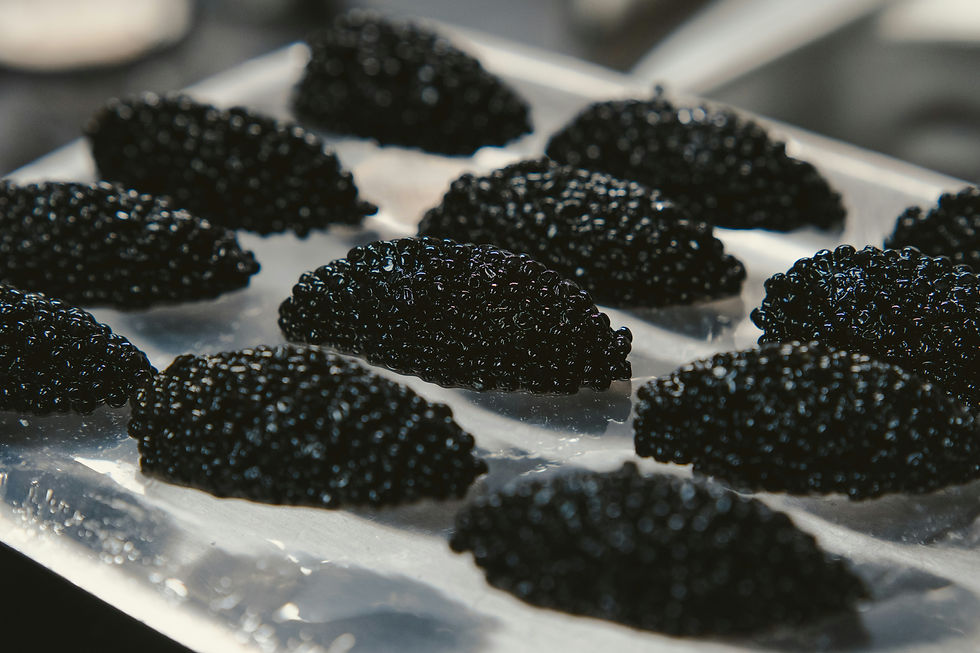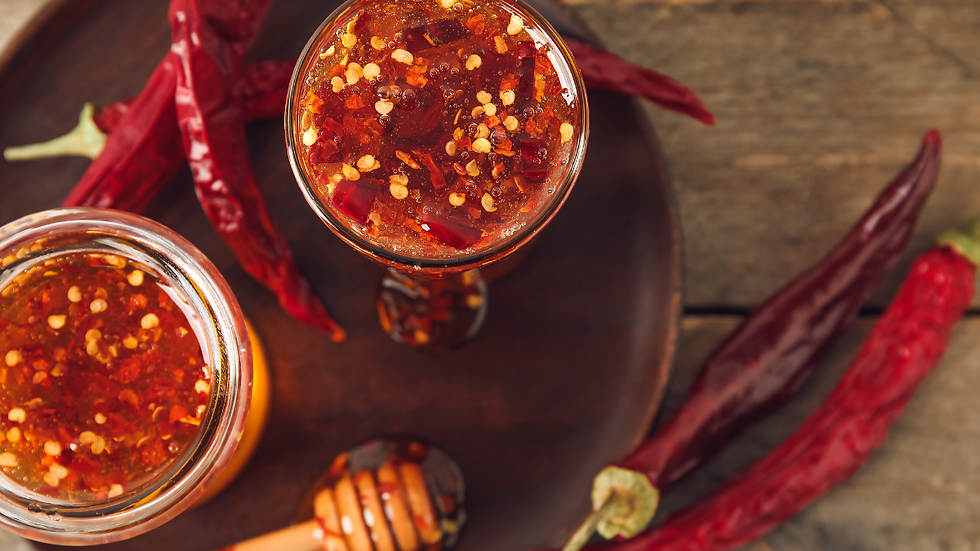World’s Most Luxurious Delicacy: Here Is A Guide To Caviar And How To Enjoy It
- Tanmaya Kothari

- Sep 7
- 4 min read
“Timeless, sophisticated craftsmanship, elegance, beauty, discovery and great taste.”

Sounds like a description of an architectural icon? Maybe it's an appraisal of an art piece? Or is it about a transcendental novel?
No, it’s actually how John Knierim, vice president and secretary of Calvisius Caviar USA, gushes about the humble fish egg. Quite frankly, there is nothing humble about the “fish eggs” he describes in this quote. He talks specifically about roe (fish eggs) from a sturgeon called “Caviar”
Caviar is one of the world’s oldest and most luxurious delicacies, once reserved for the wealthy or royal due to the sturgeon being exclusively from the Caspian and Black Seas. However, it is now more widely available, still expensive, and has become an easy way to make an extravagant event out of a ho-hum Wednesday night.
But if you're new to the world of roe, the terminology can be daunting, so whether you’re aiming to impress at your next dinner party or simply want to sound savvy when ordering, understanding the main types of caviar is an excellent place to start.
Weird History
Before jumping into the types of caviar, let’s talk about its history because it sure has a weird one, like did you know caviar used to be so cheap in the USA that it was given away for free in bars to encourage patrons to drink? It’s true!
Caviar, savored since the 1200s, originates from the Persian word “khâvyâr” and was cherished by societies around the Caspian and Black Seas. The delicacy reached European courts in the 1500s, where sturgeon earned the title "Royal Fish" in Britain. In America, particularly Jamestown, sturgeon was abundant and vital for survival. However, failed exports to Britain, due to spoilage, led colonists to regard it as poor man's fare.

The caviar narrative shifted in the mid-1800s when European immigrants in the U.S. consumed sturgeon as affordable meat, amidst declining European caviar from overfishing. This spurred the establishment of East Coast caviar processing plants, positioning the U.S. as a top exporter to Europe for two decades. Overfishing slashed sturgeon stocks from 7 million pounds in 1887 to a mere 400 pounds by 1989. Ironically, much American caviar was rebranded as "Russian caviar" in Europe, while unbranded types were bar staples. With East Coast sturgeon depleted, production moved to the Great Lakes and Pacific Northwest, but similar overfishing and environmental issues endangered sturgeon species globally.
Types Of Caviar
Finally, now that we have gotten some groundwork on what caviar actually is, let us dive into the world of different types of caviar, from the well-known to the lesser-known but no less deserving:
Caviar Type | Egg size | Colour | Taste | Fun fact |
Beluga | Largest | Silver to Dark | Buttery and delicate | Sturgeon can live 100+ years |
Ossetra | Medium | Golden to brown | Nutty and Briny | Golden eggs are especially rare and prized |
Sevruga | Small | Dark Grey/Black | Salty and Bold | One of the smallest and fastest-maturing sturgeon species |
Siberian | Medium | Dark | Mild and Clean | Popular for sustainability |
White | Small | Jet Black | Earthy and nutty | North American sturgeon caviar |
SERVING AND EATING CAVIAR
Serving and savoring caviar offers a unique culinary experience steeped in heritage. While opinions on the best approach vary, there is no absolute method for enjoying this delicacy. Ideally, caviar should be served directly from the refrigerator, placed in a bowl of crushed ice to maintain its freshness. Freezing it is inadvisable, as it compromises the texture. Utilize glass, porcelain, mother-of-pearl, or plastic bowls to avoid the metallic taste imparted by metal. Similarly, choose mother-of-pearl, wood, gold, or plastic spoons for serving.
When hosting, allocate between half an ounce and one ounce per guest. Invite them to relish the rich, explosive flavors in each bite, celebrating the caviar’s distinct character.

WHAT TO PAIR WITH CAVIAR
Caviar truly excels when it takes center stage, so opt for classic pairings. Its buttery taste, with a hint of fishiness, is reminiscent of raw oysters but offers a richer essence. As you savor it, you might detect nutty, bright, or smooth flavor nuances. Serve caviar with blinis or thin toast points with butter for a traditional touch. For a casual elegance, pair it with kettle chips or brioche slices. Alternatively, enjoy it directly from the spoon or with a "caviar bump" from the hand. Allow the caviar to roll across your tongue, revealing its subtle brine, creaminess, and clean finish.
Caviar enhances a variety of exquisite recipes, and its distinct flavors make it a superb companion to buttery dishes and savory delights, such as:
Pasta
Potatoes
Smoked salmon
Cheese
Veggies
Fruits
Chocolate
You can also find delicious drinks to complement your caviar. Vodka and Champagne are classic drink pairings for this delicacy, but you can also consider a dry white wine, porter, or amber ale. A dirty martini with a caviar bump on the side is perfect, too.
HOW TO SELECT QUALITY CAVIAR
Pearl size is a vital marker of caviar quality, with larger pearls from mature sturgeon being both rare and highly sought after. These eggs boast a firmer shell, richer flavour, glossy sheen, and uniform look. Caviar is categorised into two grades:
Grade 1: Characterised by large, intact, firm eggs with consistent colouring.
Grade 2: Consists of smaller, softer, and less uniform caviar, which is less refined yet still flavourful.
Exceptional caviar undergoes minimal processing, comprising only roe and a hint of salt. Avoid preservatives like borax or heavy pasteurisation, as they may prolong shelf life but diminish flavour and texture.

The Final Word
Understanding the fundamental types of caviar, their distinct characteristics, and the various ways they are savoured will not only deepen your appreciation for this exquisite delicacy but also provide you with the expertise to navigate a caviar menu with confidence. Venture forth, taste, and leave a lasting impression.
When you next encounter caviar at an event, take the opportunity to sample it and discern its unique flavour nuances.




Comments